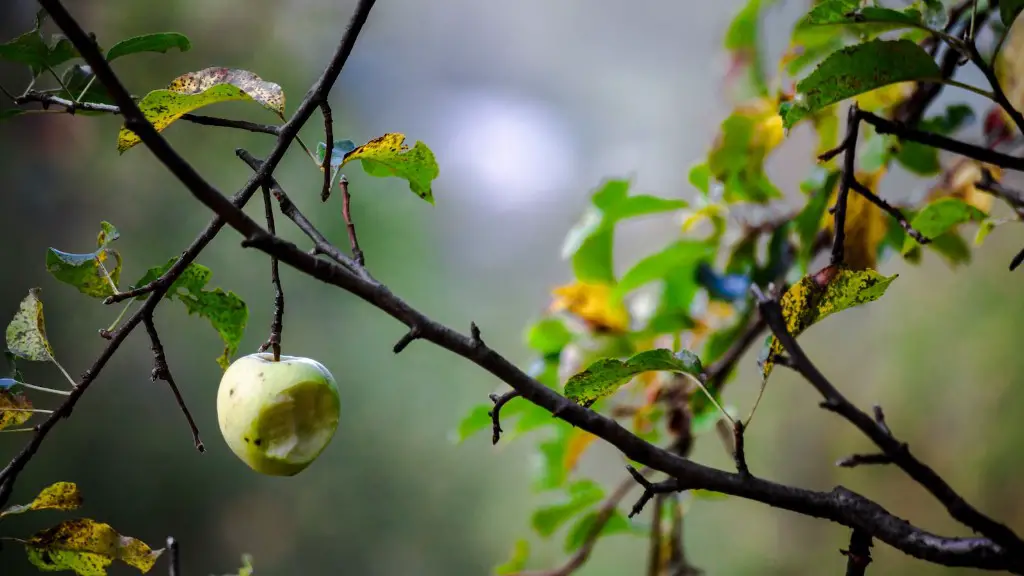Can apples be eaten directly from the tree? The answer is yes! In fact, one of the best ways to enjoy apples is to pick them fresh off the branches and savor the sweet, juicy taste. Apples can also be eaten when they are under-ripe, providing a tart flavor.
Harvesting apples straight from the tree requires a greater understanding and knowledge of the species and variety. It is important to know when the fruits are ripe, as some apples can be eaten when they are still green while others must be fully ripe before they can be safely consumed. Furthermore, harvesting apples must be done carefully, as any rough handling may cause bruising or harm the fruit.
Apples that are harvested directly from a tree are often more flavorful than those found in a grocery store. For many varieties, flavor depends on the time that it takes to get from the tree to table. Apples that spend less time in transport are fresher and typically have more pronounced flavors. Additionally, homegrown apples are often crunchier than those purchased from a store.
The quality of apples from a tree also depends on the care taken during the growing season. Apples must be pruned and tended to regularly through the growing season in order to obtain the best results. This includes fertilizing, pest control, and pruning to ensure the trees produce a bountiful harvest.
Eating apples straight from the tree is a wonderful experience and one that offers an unparalleled level of freshness. Freshly-picked apples can be eaten as-is or used in a variety of recipes. Enjoying these fruits straight from the tree is an enjoyable and healthy way to experience apples at their peak of flavor and crunchiness.
Uses of Apples Directly from the Tree
Once apples have been picked from the tree, there are a variety of uses for them. Of course, they can simply be eaten fresh as a delicious and nutritious snack. Apples are full of vitamins, minerals, and fiber, making them a great choice for health-conscious individuals. In addition, apples can be used in a variety of recipes.
From apple pie and cobblers to tarts and crumbles to juicing, apples can be used in any recipe that calls for fresh fruit. Apples can also be dehydrated or frozen to preserve their flavor and locked in their vitamins and minerals. Moreover, apples can be made into jams, jellies, and preserves that can be used in sweet and savory dishes. Apple juice is another popular way to enjoy freshly-picked apples.
Apple cider vinegar is another product that can be made from freshly-harvested apples. This vinegar has numerous health benefits, including aiding in digestion and boosting immunity. Apple cider vinegar can also be used as a base for making salad dressings and reducing sauces. The uses of apples freshly-picked from the tree are almost endless!
Apples keep well for a few days at room temperature, but in order to enjoy a longer shelf-life, they should be stored in the refrigerator. Apples that are refrigerated should be consumed within one to two weeks, otherwise, they may start to lose their flavor and crunch. Applesauce is another recipe that can be frozen or canned, so that any surplus produce can be enjoyed even if it is not used immediately.
Apple Varieties & Best Practices
When selecting apples to be harvested from the tree, it is important to consider the variety being used. Certain apples may be better suited for eating fresh or storing, while others may be better for baking or juicing. Fortunately, there are many varieties of apples to choose from, and the process of selecting, planting, and caring for trees can be quite fun.
In order to maximize the potential of a particular apple tree, it is important to follow best practices when harvesting the fruit. This includes pruning the tree regularly, controlling pests, and fertilizing it. It is important to note that pruning and fertilizing should be done at the right times of the year in order to get the best results. Furthermore, the selection of apples should be based on when they are ready, as some apples can be eaten when they are still green and some must be fully ripe.
Once the apples are ready to be harvested, it is important to use the appropriate tools and techniques. Apples should never be torn from the tree as this can damage the fruit. Instead, a ladder should be used to reach any higher apples, and a fruit picker or a pruning saw should be used to cut the apples from the tree. Apples should then be carefully placed into harvest bins for transport.
When preparing apples for use in recipes, it is important to consider their texture. Apples that are too soft or overly ripe may not hold their shape when cooked, while apples that are too hard and under-ripe may not become tender. Furthermore, apples of the same variety can have different textures, so it is important to taste before using in a recipe.
Nutritional Value of Apples
Apples are densely packed with essential vitamins and minerals, providing numerous health benefits. Apples contain vitamin C, which helps the body to fight off illnesses, and vitamin K, which is important for blood clotting. Apples are also high in fiber, which helps to aid digestion, and provide a healthy dose of antioxidants, which can protect against certain illnesses and diseases.
Apples provide a wide range of phytonutrients, including quercetin and chlorogenic acid, which are both known for their powerful anti-oxidant properties. Moreover, apples contain boron and vitamins A, B-complex, D, E, and K, which have all been linked to improved health outcomes. Furthermore, apples provide a modest amount of protein and carbohydrates, which help to provide needed energy.
Apples contain a relatively low amount of calories and sugars, making them an excellent choice for those looking to manage their weight. Additionally, apples are free from cholesterol and sodium, and are a great source of vitamins and minerals, making them a nutritionally-dense food. This makes them an ideal snack or part of a meal for those looking to maintain a healthy diet.
Considerations & Precautions
Eating an apple directly from the tree is a rewarding experience, however, some precautions should be taken. Apples can be sprayed with chemicals in order to improve their size and color, so it is important to wash the fruit well before consumption. Additionally, it is important to only consume apples from trees that are known to be biologically sound and have been tended to throughout the season.
In certain cases, it may be preferable to leave apples on the tree, as their flavor and quality tends to improve when left for a few weeks. This is especially true for tart varieties, such as Granny Smith apples. Additionally, apples are among the fruits most likely to be contaminated with pesticide residue, so organic varieties should be sought out whenever possible.
Finally, it is important to keep in mind that apples can contain small amounts of cyanogenic glycosides, which can cause cyanide poisoning if consumed in large quantities. Therefore, individuals should only consume a moderate amount of apples. Additionally, children and pregnant or breastfeeding women should be cautious when consuming apples, as larger amounts of these compounds can cause health issues.




